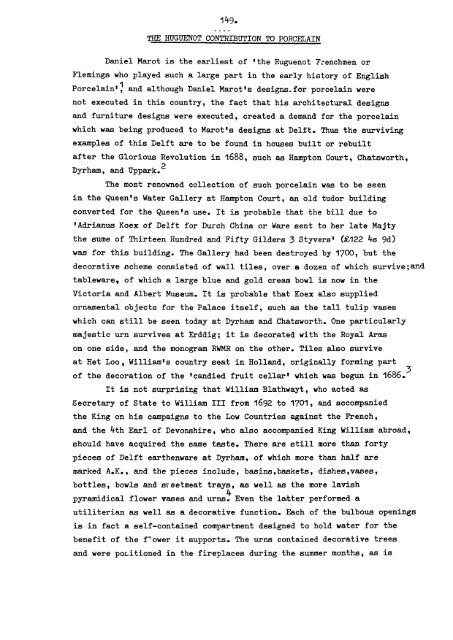HUGIJENOT ARTISTS DESIGNERS AND CRAYPSNEN IN GREAT ...
HUGIJENOT ARTISTS DESIGNERS AND CRAYPSNEN IN GREAT ...
HUGIJENOT ARTISTS DESIGNERS AND CRAYPSNEN IN GREAT ...
Create successful ePaper yourself
Turn your PDF publications into a flip-book with our unique Google optimized e-Paper software.
I<br />
T}IE HETGUENOT CONTRIBtTTION TO PORCELA<strong>IN</strong><br />
Daniel Marot is the earliest of 'the Huguenot ':enchmen or<br />
Flemings who played such a large part in the early history of English<br />
Porcelain' and although Daniel Marot's designsfor porcelain were<br />
not executed in this country, the fact that his architectural designs<br />
and furniture designs were executed, created a demand for the porcelain<br />
which was being produced to Marot's designs at Delft. Thus the surviving<br />
examples of this Deift are to be found in houses built or rebuilt<br />
after the Glorious Revolution in 1688, such as Hampton Court, Chatsworth,<br />
Dyrham, and Uppark.2<br />
The most renowned collection of such porcelain was to be seen<br />
in the Queen's Water Gallery at Hampton Court, an old tudor building<br />
converted for the Queen's use. It is probable that the bill due to<br />
'Adrianus Koex of Deift for Durch China or Ware sent to her late Majty<br />
the sume of Thirteen Hundred and Fifty Gilders 3 Styvers' (122 4-s 9d)<br />
was for this building. The Gallery had been destroyed by 1700, but the<br />
decorative scheme consisted of wall tiles, over a dozen of which survive;and<br />
tableware, of which a large blue and gold cream bowl is now in the<br />
Victoria and Albert Museum. It is probable that Koex also supplied<br />
ornamental objects for the Palace itself, such as the tall tulip vases<br />
which can still be seen today at Dyrham and Chatsworth. One particularly<br />
majestic urn survives at Erddig; it is decorated with the Royal Arms<br />
on one side, and the monogram RWMR on the other. Tiles also survive<br />
at Het Lao, William's country seat in Holland, originally forming part<br />
of the decoration of the 'candied fruit cellar' which was begun in 1686.<br />
It is not surprising that William Blathwayt, who acted as<br />
Secretary of State to William III from 1692 to 1701, and accompanied<br />
the King on his campaigns to the Low Countries against the French,<br />
and the kth Earl of Devonshire, who also accompanied King William abroad,<br />
should have acquired the same taste. There are still more than forty<br />
pieces of Deift earthenware at Dyrham, of which more than half are<br />
marked A.K., and the pieces include, basins,baskets, dishes,vases,<br />
bottles, bowls and steetmeat trays, as well as the more lavish<br />
pyraxnidical flower vases and urns. Even the latter performed a<br />
utiliterian as well as a decorative function. Each of the bulbous openings<br />
is in fact a self-contained compartment designed to hold water for the<br />
benefit of the Vower it supports. The urns contained decorative trees<br />
and were pozitioned in the fireplaces during the summer months, as is
















